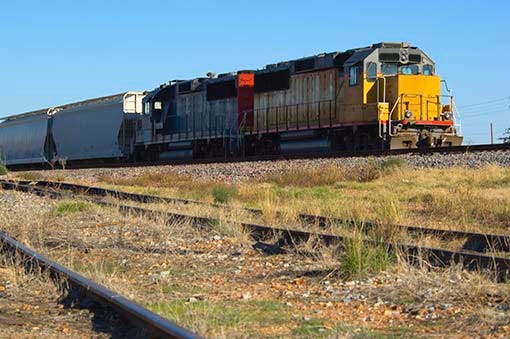BNSF Railway improves overall score by 26% in 2015 after past challenges.

Overall results across the nation’s seven largest railroads in 2015 were 1% lower than in 2014 after agricultural shippers provided mixed reviews in the sixth annual Soy Transportation Coalition (STC) “Railroad Report Card.” For the fourth time, Union Pacific was regarded as the top-performing railroad, while BNSF Railway was rated as most improved, increasing its overall score by 26% from the previous year. Survey respondents ranked Canadian Pacific in last place for the fifth year in a row.

Union Pacific deemed top-performing railroad for fourth consecutive year.Source: miflippo/iStock/Thinkstock.
Three of the seven evaluated railroads – Union Pacific, BNSF and Canadian Pacific – were provided higher overall scores from 2014. Four of the seven – CSX, Norfolk Southern, Canadian National and Kansas City Southern – were given lower overall scores.
The survey was completed anonymously by agricultural shippers of various sizes and scale of operations and has been comprised of the same 11 questions since the report card’s inception. Surveys were completed and submitted during September through November. The questions are categorized under: (1) on-time performance, (2) customer service and (3) costs. For most questions, participants were asked to rate each of the seven Class I railroads on a scale from one to 10, with 10 being the highest score and one being the lowest.
After combining the results from the 11 survey questions, Union Pacific received the highest overall rating, ranking first in eight out of the 11 questions. Lowest-performing Canadian Pacific received a last-place ranking in nine of the 11 questions.
STC Rail Customer Satisfaction Index – Overall Ratings:
1. Union Pacific Railroad
2. BNSF Railway
3. CSX Transportation
4. Norfolk Southern Railway
5. Canadian National Railway
6. Kansas City Southern Railway
7. Canadian Pacific Railway
Increased ratings for certain railroads were balanced by lower ratings for others. Survey respondents in 2015 rated railroads 17% higher in their ability to provide on-time service and 5% higher in customer service. In contrast, agricultural shippers rated railroads 6% lower in providing transparency in their pricing mechanism and 6% lower in providing adequate notification when price increases occur.
“Railroads are essential to the profitability of the U.S. agriculture,” said Scott Gauslow, a soybean farmer from Colfax, N.D., and chairman of STC. “Even though farmers in many states, like North Dakota, may be far removed from our coasts and our nation’s inland waterway system, our freight railroads allow our production to be exported throughout the world. We congratulate those railroads – particularly Union Pacific and BNSF – for providing quality service over the past year to their agricultural customers.”
In addition to Union Pacific’s continued top ranking, BNSF received a dramatically higher score in 2015 compared to the previous year.
STC executive director Mike Steenhoek explained, “In 2014, BNSF did not provide the type of service agricultural customers expect and BNSF demands from itself. A particularly severe winter, competition from crude oil and other contributing factors resulted in many agricultural shippers throughout the country experiencing a significant downturn in rail service. Fortunately, BNSF responded by not only investing in new capacity but also aggressively communicating with their agricultural customers.”
Steenhoek said the survey responses clearly reflect that while rail service will never be perfect, the picture has significantly improved from 2014.
Class I railroads are the largest railroads in the country, with an annual operating revenue exceeding $475 million. Seven railroads are classified as Class I: BNSF Railway, CSX Transportation, Kansas City Southern Railway, Norfolk Southern Railway and Union Pacific Railroad. Canadian National Railway and Canadian Pacific Railway are also considered Class I due to their significant trackage lines in the U.S.
About the Author(s)
You May Also Like
.png?width=300&auto=webp&quality=80&disable=upscale)


